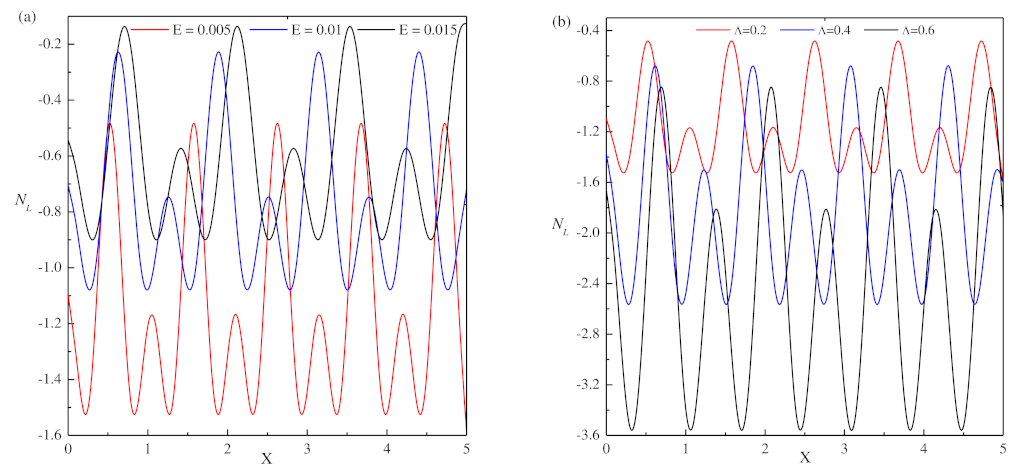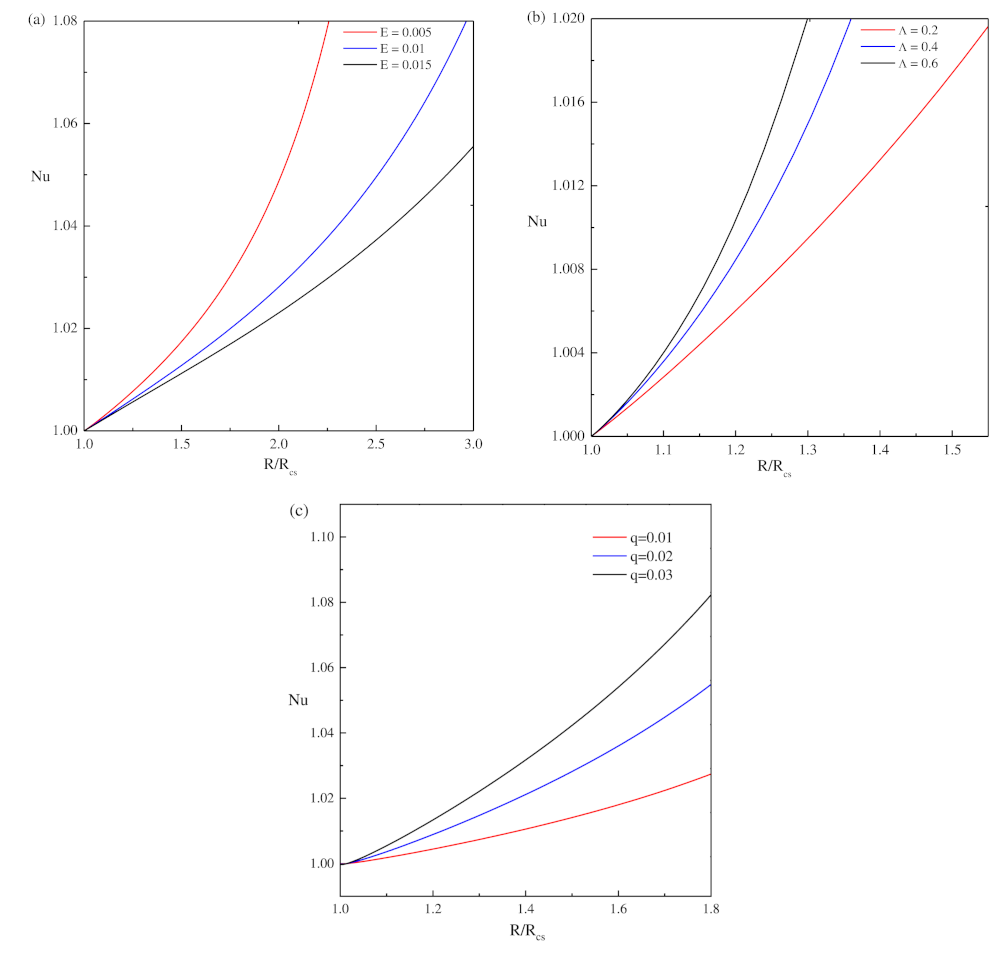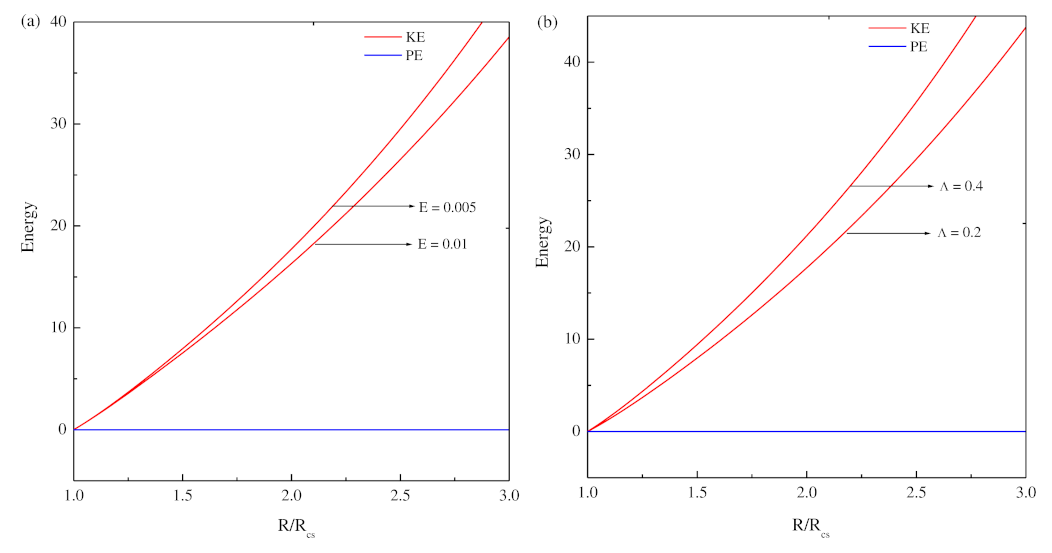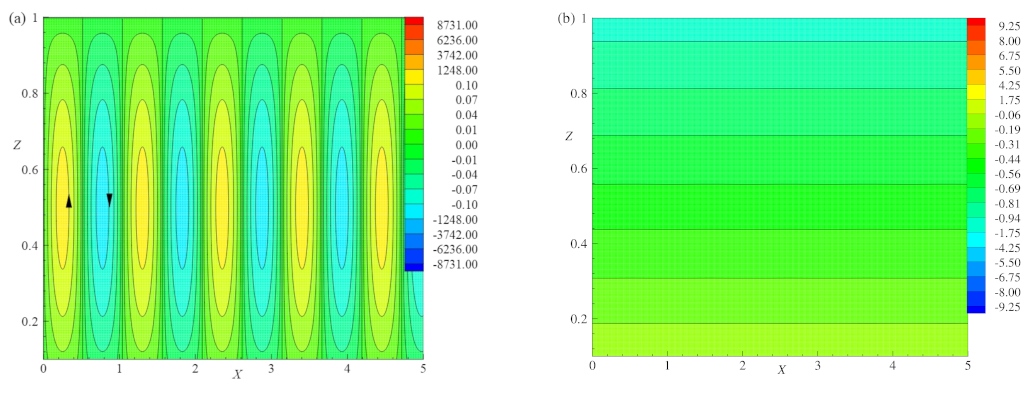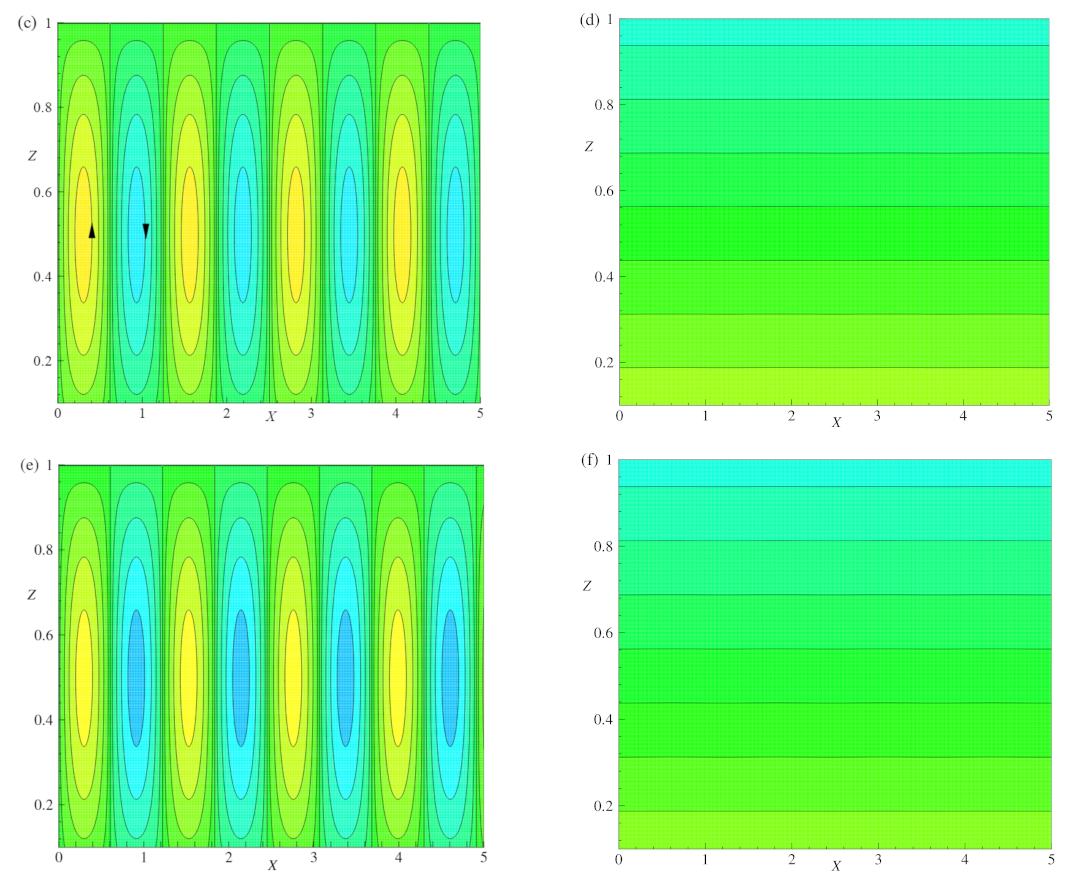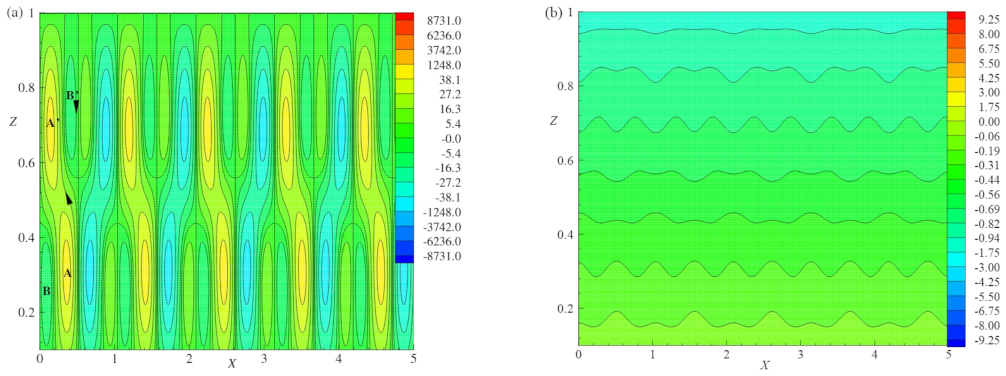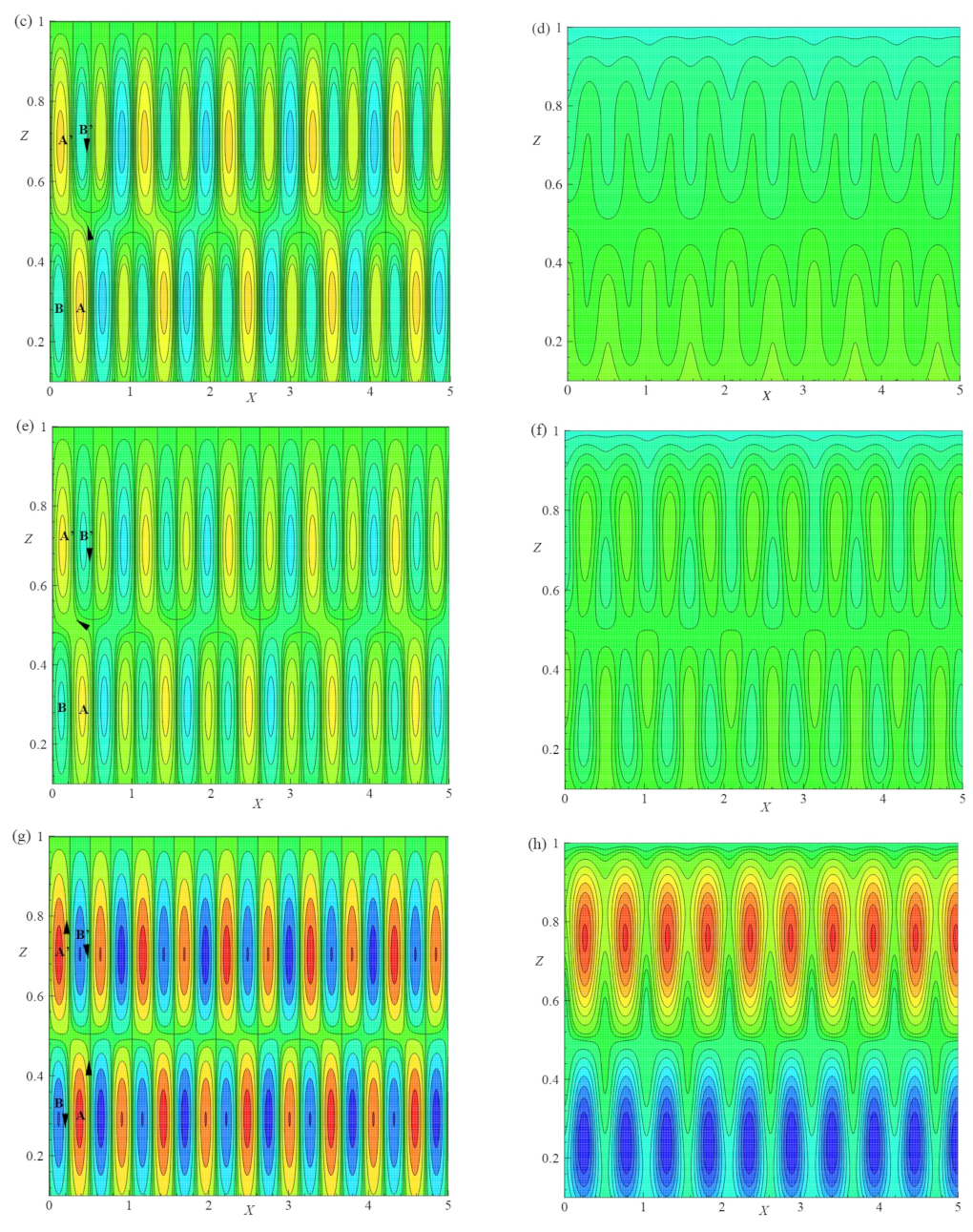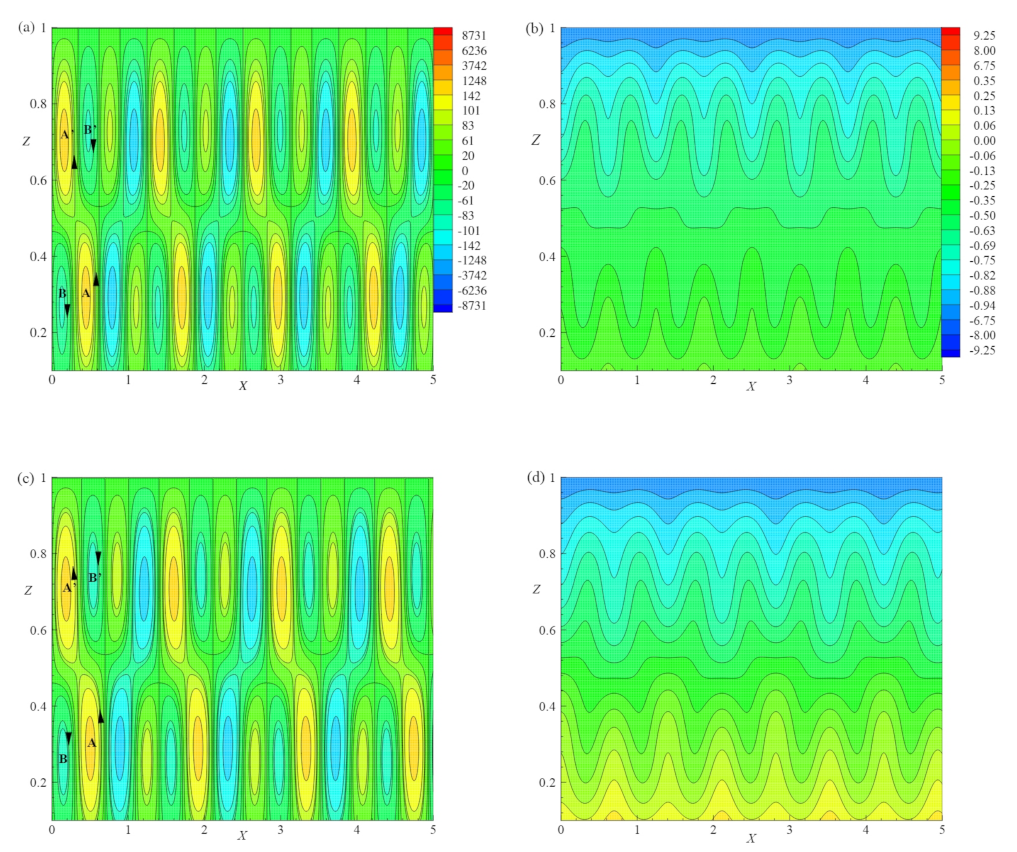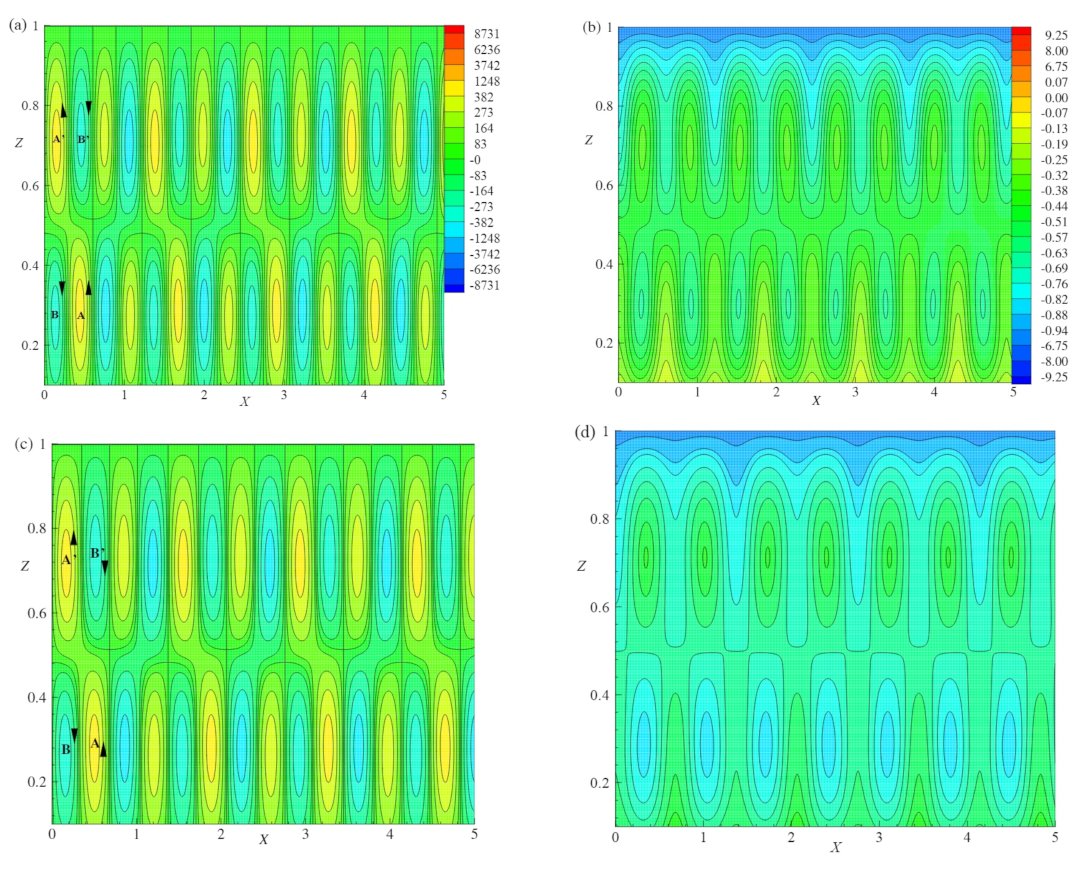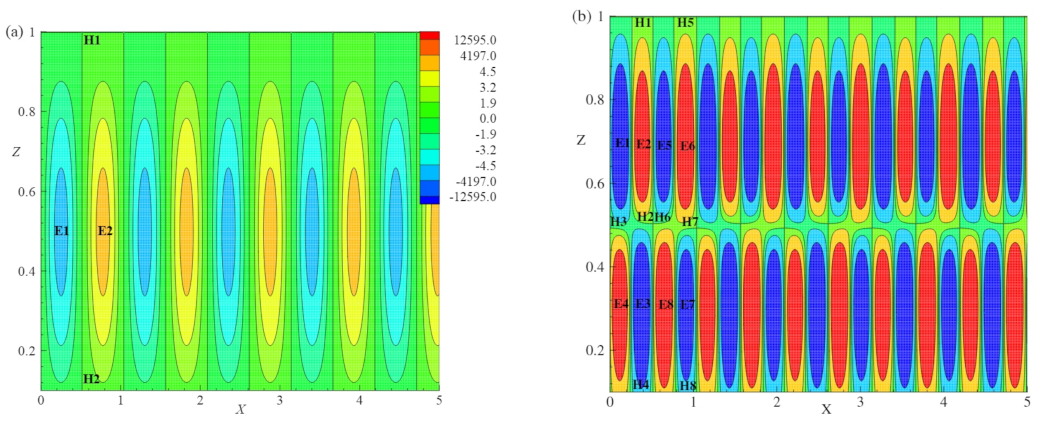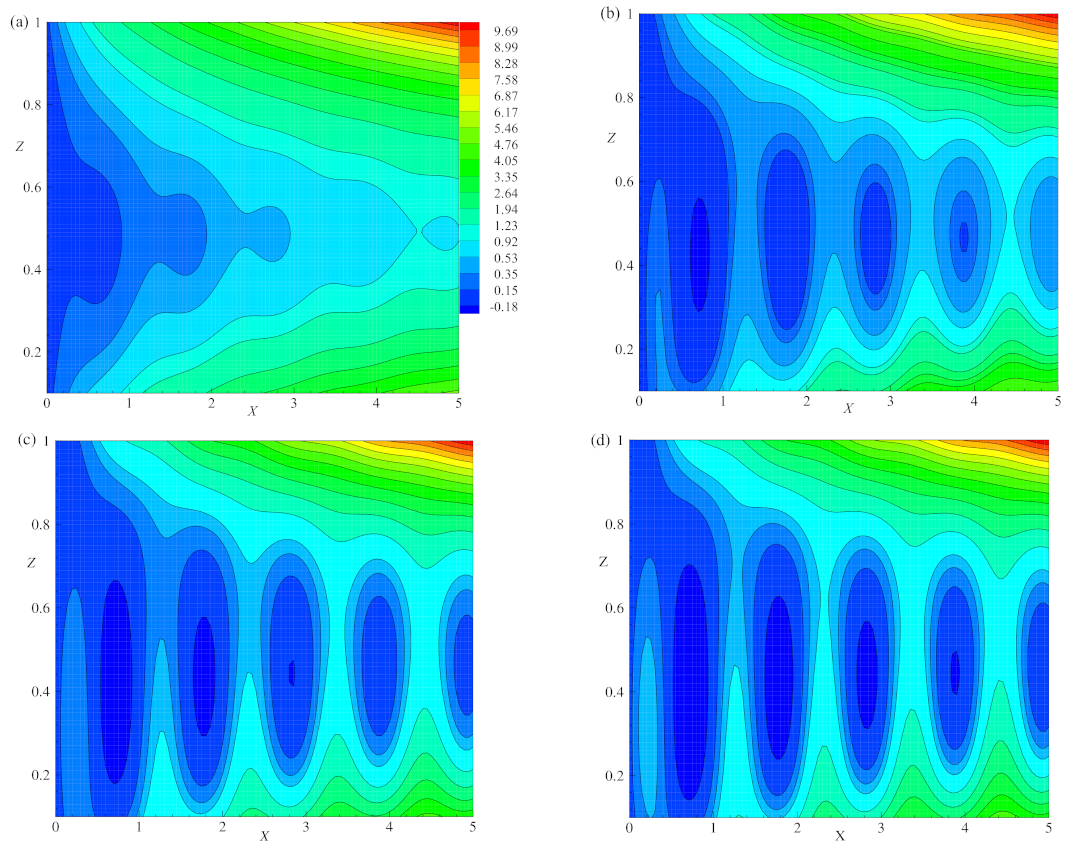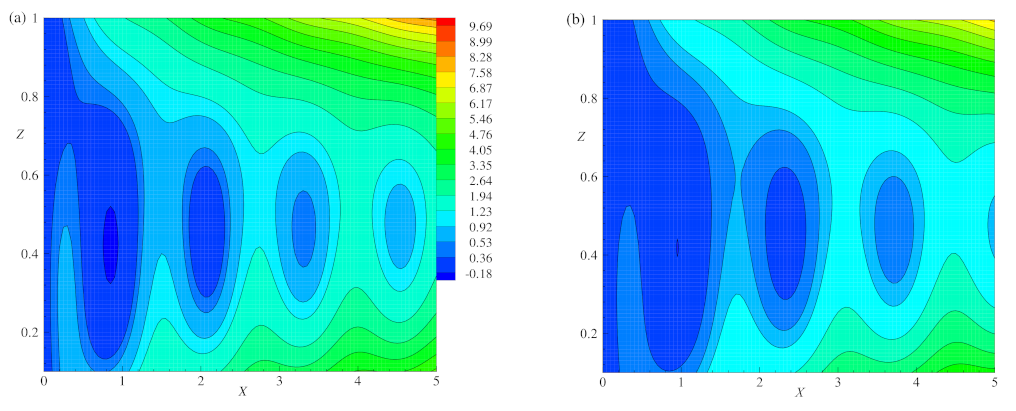1. Introduction
In astrophysical and geophysical models related to the Sun, stars, and the outer core of Earth, the convection is affected by both the Coriolis and Lorenz forces. Such a rotating magnetoconvection model with Boussinesq approximation has been studied by many authors, for example, Chandrasekhar [
1], Roberts [
2], and Cox and Matthews [
3], etc. The linear stability analysis of this model shows the system is unstable with respect to either stationary convection or oscillatory convection and depends on the governing physical parameters, namely, Rayleigh number (
R), Chandrasekhar number (
Q), Taylor number (
), thermal Prandtl number (
), and magnetic Prandtl number (
) or Roberts number. Most of the experimental studies on Rayleigh–Bénard convection (
), rotating Rayleigh–Bénard convection, magnetoconvection, and rotating magnetoconvection (
) have focused on heat transfer laws. When the control parameter
R exceeds its critical value, a cellular regime of steady convection starts to appear. In addition, the motion increases its intensity but remains laminar and steady for a large range of values of
R, followed by unsteady turbulent convection. Finite amplitude cellular convection with better approximate solutions has been studied for
by Malkus and Veronis [
4] and Kuo [
5].
In
with
and
, the critical
R (
) remains approximately a constant until
Q reaches a certain value. When
Q increases further,
starts to decrease, reaches a minimum and again starts to increase (Chandrasekhar, [
1]). Braginsky [
6] also studied these rotating magnetic systems and stressed the importance of the Archimedean, magnetic, and Coriolis forces. He revealed that these forces, together with the pressure gradient, would determine the dynamic balance and inertial forces. Eltayeb [
7] considered the linear stability analysis to analyze the convection in the hydromagnetic rotating layer. He observed when the principle of exchange of stabilities is valid, four different models can be classified based on the relative directions of the constant magnetic field,
and
, (
,
) namely, (vertical, vertical); (horizontal, vertical); (horizontal, horizontal); (vertical, horizontal) and also for different types of boundaries. The numerical results indicated that the asymptotic dependence of
on
and
Q are equal and independent of the nature of the boundary conditions considered. Later, Eltayeb [
8] extended his previous model [
7] to study the convective motions near the onset of oscillatory convection. He classified three different motions near the onset, namely: (i)
, the results for the rotating non-magnetic case, which are retained to leading order; (ii)
, the results are similar to those for the magnetic non-rotating case to leading order; and (iii)
and
Q are of same order, the minimum temperature gradient required for the instability is greatly reduced. When these solutions were examined in detail, it was observed that the motions that follow the onset of instability depended primarily on the electrical conductivity rather than on the kinematic properties of boundaries. In addition, in the leading order, the boundary conditions to be applied to the mainstream solutions depended on the conductivity of the boundary but not on the no-slip conditions. When either of the magnetic field or rotation were dominant, there was a possibility of the occurrence of two-dimensional motion. In this case, the Taylor–Proudman theorem was satisfied, while when both magnetic field and rotation were influential, this theorem was no longer valid and the motions were essentially of three-dimensional in nature.
The important laboratory experiments on
, rotating
and magnetoconvection
using the liquid gallium (
) as the working fluid have been carried out by Aurnou and Olson [
9]. The properties of liquid gallium are similar to those of the liquid iron in the Earth core. The studies of magnetoconvection have vast industrial applications too [
10,
11]. The
for the magnetoconvection is experimentally determined as a function of
Q and
. At low rotation rates, the
increases linearly with magnetic field intensity. At moderate rotation rates, coherent thermal oscillations were detected by Aurnou and Olson [
9] near the onset of convection. These experimental results at the onset were compared with the theoretical predictions of Chandrasekhar [
1]. In nearly all of the experimental results, it was mentioned that no well-defined steady convective regime was found. Instead, unsteady or turbulent convection was detected just after onset. Later, these experimental predictions were reproduced by using direct numerical simulations near the onset (Rani et al. [
12]). These simulations showed the occurrence of interesting cell patterns. The most relevant geodynamo models were given by Roberts and Jones [
13], who extended the model of Braginsky [
14] with two sets of boundary conditions.
The present nonlinear convection problem is studied based on the plane layer model proposed by Roberts and Jones [
13]. In astrophysics and even in planetary physics, the model considered by Roberts and Jones [
13] is yet sufficiently close to reality and is, really, heuristic. This model is very convenient for laboratory experiments, too, which have not yet been done. The linear planer layer dynamo model was considered by Roberts and Jones [
13] with the limiting case of Prandtl number tending to infinity. This limiting case enabled the removal of the inertial terms and thus the resultant linearized equation of motion filtered the fast-inertial modes and Alfven waves. The main reason for considering this limiting case was that it simplified the analysis considerably and could able to exhibit an amazingly rich structure. The other motivation was that it is an important limit for geodynamo modelling, in which fast modes are believed to be relatively unimportant.
In the linear stability analysis of the planer layer problem [
13], the effect of physical parameters such as
E,
,
R, and
q have been thoroughly studied for the occurrence of parallel rolls, cross rolls, and oblique rolls at the onset of convection. In general,
E and
represent the geophysical models but with these values, it is very difficult to simulate these models and obtain the converged results. This difficulty can be overcome by using one of the approximate methods, such as weakly nonlinear analysis, which yields comparable results with the experimental observations. This method of weakly nonlinear analysis was applied for the Braginsky [
14] model by Roberts and Stewartson [
15] near the onset of oscillatory convection using the small finite amplitude equations. Further, they have analyzed the linear stability analysis of the cubic and cubic-quintic amplitude equations. These amplitude equations are valid only when
R is close to the
. In addition, the nonlinear analysis proposed by Malkus and Veronis [
4] is valid when the
R is near the threshold
. Later Kuo [
5] proposed a different nonlinear approach, which is valid even for large values of
R. The advantages of this approach are that the solutions are found to be valid even for a large range of the imposed temperature differences across the fluid layer and also the rapid convergence of solutions. This solution provides a quantitative theory for the convective heat transport as a function of the temperature difference in the range of laminar flow. Using this approach by Kuo [
5], Rameshwar et al., [
16], have studied the finite amplitude cellular convection in
under the influence of a vertical magnetic field and analyzed the magnetohydrodynamics (
) of electrically conducting fluid. Linear and nonlinear properties of thermohaline convection at the onset with the stress-free boundary conditions were investigated using perturbation analysis relevant to oceanic water and groundwater by Rawoof Sayeed and Rameshwar [
17]. The stationary and oscillatory finite amplitude convections of a binary mixture with a porous medium were thoroughly investigated by Rameshwar et al., [
18,
19]. Baklouti et. al. [
20] studied the dynamics of incompressible homogeneous turbulence by numerical simulations. Gupta et. al. [
21] have analytically examined the effect of rotational speed modulation on the onset of magneto-thermal convection.
The extension studies related to geodynamo models proposed by Eltayeb [
7,
8], Roberts and Jones [
13], and Jones and Roberts [
22] have been studied by Šoltis and Brestenský [
23]. The authors Šoltis and Brestenský [
23] studied the influence of anisotropic diffusive coefficients (thermal diffusion and viscosity) on marginal stability of the horizontal fluid planar layer rotating about the vertical axis and permeated by a horizontal homogeneous magnetic field. The linear stability analysis was thoroughly investigated by the authors for two different types of anisotropic diffusive coefficients. This model was further extended to study the linear stability of the model of rotating magnetoconvection in the horizontal planar layer dynamo by Filippi et al. [
24], which is influenced by three anisotropic diffusivities, such as viscosity, thermal diffusivity, and magnetic diffusivity.
In the present study, the nonlinear analysis was employed as proposed by Kuo [
5] to study the behavior of cross rolls of electrically conducting fluid in a rotating magnetic system, given by Roberts and Jones [
13]. Thus, the objectives of the present problem were as follows:
Investigate theoretically the nonlinear behavior of cross rolls which occur in the vertically rotating Rayleigh–Bénard convective system of planar layer of electrically conducting fluid in the presence of horizontal magnetic field;
Solve the nonlinear partial differential equations using the perturbation method proposed by Kuo [
5], until the
O(
) and obtain the approximate solutions;
Obtain the combined effect of Lorenz and Coriolis forces with stress-free boundaries;
Find the local () and average () Nusselt numbers on the hot wall to understand the development of heat flow and the rate of heat transfer, respectively;
Obtain the cellular pattern of the fluid flow (streamlines) and hot regions (isotherms) from the eigenfunctions related to stream function and temperature, respectively;
Study the heatline patterns of the flow by using the heat function.
The novelty of the present work is the study of finite amplitude cellular convection when the stationary convection exists as a first instability. The dynamical behavior of the system depends on the type of instabilities that occur in that system. Interesting convective instabilities occur near the onset of convection which is analyzed from the linear stability analysis. At the onset of convection, the system is unstable to either stationary convection (at least one eigenvalue vanishes) or oscillatory convection (an eigenvalue with a purely imaginary part) as a first instability. When an eigenvalue vanishes the principle of exchange of stabilities occurs. In other words, a new steady state replaces the stable motionless state of the fluid. When stationary convection exists, the continuous release of potential energy is balanced by the viscous dissipation of mechanical energy and the convection always occurs in a fairly regular pattern. The results from the linear stability analysis of Roberts and Jones [
13] show the occurrence of the modes such as parallel rolls, cross rolls, and oblique rolls based on the wave numbers. Only stationary convection exists as a first instability when the parallel rolls occur, but for the modes of cross rolls and oblique rolls, both stationary convection and oscillatory convection can occur as a first instability depending on the physical parameters. A detailed investigation of the linear stability analysis of the present physical model has been studied by Roberts and Jones [
13]. Hence, the nonlinear dynamical behavior of the present considered physical model is investigated when stationary convection exists.
In
Section 2, the basic governing equations that are considered by Roberts and Jones [
13] are presented. The linear stability analysis is discussed in
Section 3 to obtain critical Rayleigh numbers for steady cross roll modes. The nonlinear solutions for the field variables are presented in
Section 4. In
Section 5, the local Nusselt number (
) and average Nusselt number (
) are discussed. The distortion of streamlines and isotherms is discussed in
Section 6. The heat flow visualization is discussed in
Section 7. Finally, the conclusions are presented in
Section 8.
2. Mathematical Model
In the present study the fluid with uniform density confined in an infinite horizontal layer was considered. It was assumed that the whole configuration rotates about the vertical axis (
) with angular velocity
in the presence of a uniform gravitational field
and the uniform magnetic field
applied in the horizontal direction where
is the unit vector along the
X-axis and
is the unit vector along
Z-axis. The Prandtl number is assumed to be large, so as to ignore the inertial forces in the momentum equation in comparison to the Coriolis force [
13]:
where
includes the centrifugal force,
is the electric current density, and other notations are given the nomenclature.
We non-dimensionalized the Equations (
1)–(
5) using the corresponding length, time, velocity, temperature, magnetic field, and pressure scales as
, and 2
, respectively.
Therefore, the non-dimensional governing equations are [
13]:
where
R =
is the modified Rayleigh number, which measures the ratio of buoyancy force to Coriolis force,
is the ratio of viscous and Coriolis forces,
is the ratio of magnetic force and Coriolis force, and
is the ratio between the thermal and magnetic diffusivities (the Roberts number). For the static solutions from Equations (
6)–(
10), we obtain
After introducing the following perturbed quantities in the above static solutions, we obtain
For convenience the asterisk symbols are omitted in the further analysis. The perturbed dimensionless governing equations are given by
where
, .
Eliminating
,
, and
from the linear part of Equations (
13)–(
17), we obtain
and
where
and
Because the surfaces are maintained at a uniform temperature,
and also normal component of the velocity should vanish on boundaries, i.e.,
The conditions Equations (
19) and (
20) are independent of the nature of boundaries, such as free–free or rigid–rigid, etc. In the present work, we assumed stress-free boundary conditions [
1], hence we obtain
Since the physical system is a triple diffusive system, it is unstable to either stationary convection or oscillatory convection near the onset.
3. Linear Stability Analysis
At the onset of convection, the existing perturbations in the system are very small. Hence, the nonlinear terms are smaller when compared to linear terms. The nonlinear contributions are neglected from Equation (
18). We obtain a linear differential equation which is given as
This process is called linearization. We obtain
The resulting Equation (
23) is linear. The normal mode solution was considered as
, where
a is the wavenumber along
X direction and
l is the wavenumber along
Y direction. As such,
a and
l are real numbers and the growth rate (
p) may be constant complex number [
13]. The marginal state is obtained from
. The two types of modes are classified using the eigenvalue
p, namely, if
, then the steady modes exist and if
, then the oscillatory convection exists. The preferred mode of convection depends on the physical parameters, which are relevant to the Earth’s outer core. In Earth’s outer core, the parameters
E and
q are considered as small and the Prandtl number is large. The orientation of rolls is classified based on the wavenumber. The modes are parallel rolls, if the wavenumber
(the axis of rolls are parallel to the applied magnetic field), if the wavenumber
gives the cross rolls (the axis of the rolls are perpendicular to the applied magnetic field) and if both the wavenumbers
and
give the oblique rolls. The linear and nonlinear studies of the present physical model are based on
, i.e., cross rolls.
The physical parameters E, , q, and R are used to study the linear and nonlinear behavior of the convective system. As the temperature gradient is increased, the unstable mode may be of stationary convection or oscillatory convection near the onset. We implemented the linear stability analysis using the normal mode analysis, i.e., by substituting in the linearized equation .
Stationary Convection ()
By solving the linearized Equation (
23),
value is obtained for stationary convection and is given by
where
. The critical value of
R is obtained from
The critical wavenumber is given by
=
and the critical Rayleigh number for stationary convection is
From the above result the marginal Rayleigh number (
),
E, and
values are obtained for high rotation rates and weak field [
13] by the linear stability analysis. The critical values of control parameters were obtained to study the nonlinear behavior of cross rolls. For small values of
q, stationary convection occurs and for large values of
q oscillatory convection can occur. The value of
is free from
q while the finite amplitudes depend on
q. For the nonlinear studies, a fixed
q value as
was considered for which the stationary convection occurs as a first instability near the onset. For small values of the parameters
E and
, the minimum value
decreases as
E decreases and as
increases. Thus, the effect of
E destabilizes the convective system when
E decreases and the effect of
destabilizes the convective system when
increases (see
Figure 1).
The linear stability theory adopts a less ambitious objective to ascertain when a flow is unstable to infinitesimal disturbances. It thus gives no prediction about transition promoted by sufficiently large disturbance. The ultimate consequence of the instability is never completely determined by linear theory. Thus, in the present study, an attempt was made to understand the nonlinear convection in the presence of the Coriolis force and magnetic field.
6. Distortion of Streamlines and Isotherms
The fluid flow behavior is visualized by the stream function
which is obtained from the velocity components
U and
W. The relation between the velocity components and stream function
is [
26]
which produce a single equation
The points with equal temperature connected with lines are called isotherms. The snapshots of the heat transport and flow field near the onset of stationary convection are expressed in terms of streamlines and isotherms.
The general attributes of the streamlines and isotherms with respect to the variation in
R,
E, and
are shown in
Figure 5,
Figure 6,
Figure 7 and
Figure 8.
Figure 5 illustrates the pattern of streamlines and isotherms near the onset of convection (
).
Figure 5a, shows the pattern of streamlines for
E =
,
=
,
. The absolute maximum and the absolute minimum values of circular strengths are
and
, respectively.
Figure 5c shows the pattern of streamlines for
E =
,
=
. This figure shows the absolute maximum and the absolute minimum values of circular strengths as
and
, respectively. From
Figure 5a,c the maximum strength of rolls at
are decreased as
E increases. Thus, as
E increases,
also increases, accordingly
decreases and hence the absolute maximum of circulation strength decreases.
Figure 5e illustrate the pattern of streamlines with
E =
and
=
. These streamlines have the absolute minimum and maximum values with the circular strengths as
and
, respectively. By comparing
Figure 5a,e, the periodic rectangular rolls are observed near the
, but as
increases the maximum strength of rolls is increased and the minimum strength of roll decreases. Thus, as
increases,
decreases, accordingly
increases, and hence the absolute maximum of circulation strength increases.
Figure 5a–f are plotted for the values of
and the flow pattern are rectangular rolls and follows the symmetric nature over the range of
. Since the stream function equations show the symmetric property. Similarly, for the same values of
E and
, the isotherms formed as horizontal lines near
, as shown in
Figure 5b,d,f. At
, the strength of isotherms is of small magnitude, representing the conduction dominant heat transport inside the considered region. These isotherms are smooth lines that span over the whole region.
The snapshot of streamlines and isotherms for different values of
R and for fixed values of
,
, and
are displayed in
Figure 6a–h. It is observed that for
and for the cell lying between
, the absolute minimum and maximum values are with the circulation strengths
and
, respectively, as shown in
Figure 6a. As
R increases from
to
, the basic cells become more deformed due to the growth of two vortices
B and
located at the top right and bottom left boundaries with the circulation strength
. The basic cell with two vortices
A and
has circulation strength
. The temperature profiles in terms of isotherms are illustrated in
Figure 6b for same values of physical parameters that are considered in
Figure 6a. The isotherms are of nearly in wavy shape with the absolute maximum and minimum values of
and
, respectively. It indicates the maximum of heat transfer process is occurred by convection.
Figure 6c,d illustrate the streamlines and isotherms for
. The temperature gradient and the gravitational buoyancy force act together and changes the flow structure as shown in
Figure 6c. The bicellular patterns of streamlines turn out to be multicellular models and these cells divide the field of motion at the core for a cell lies between
with the absolute maximum and minimum values of circulation strengths
and
, respectively. The vortices
B and
showed their presence with
as the circulation strength in the opposite direction of an original cell. For these considered values of physical parameters, the behavior of isotherms is shown in
Figure 6d, which exhibit the mode of convective heat transport inside the fluid layer. In the fluid layer, the absolute maximum and minimum values of isotherms are respectively,
and
. When
R is increased from
to
, the small vortices
B and
shown in
Figure 6c are increased with circulation strength
. Thus, the basic cell encountered more deformation (
Figure 6e) and has the absolute maximum and minimum values at
and
, respectively. Accordingly, the isotherm curves develop more deformation. The absolute maximum and minimum values of isotherms in the layer are, respectively,
and
. As
R is increased from
to
(
Figure 6g), the two vortices
B and
grow in size and split the basic cell into two vortices located on either side of the secondary cell with the absolute maximum (
) and minimum (
) strengths. The heat flow pattern becomes chaotic, which is shown in
Figure 6h when
R increases to
. The absolute maximum and minimum values of isotherms in the layer are, respectively,
and
. From
Figure 6, it is observed that as
R increases from
to
, the onset of turbulent flows are producible.
Figure 7a–d, illustrate the streamlines and isotherms for different values of
E and for a fixed set of other parameters
,
, and
. The behavior of the flow field was investigated by considering the flow pattern in the region
, as shown in
Figure 6a–d (
E =
) and
Figure 7a–d (
E =
and
).
Figure 7a shows streamlines for
E =
in the considered range of
X. The absolute maximum and minimum values of circulation strengths are
and
, respectively. There exist two vortices
B and
outside the basic cell with the circulation strength
as shown in
Figure 7a. The basic cell also contains two vortices namely
A and
with a circulation strength of
.
Figure 7c is plotted for
E =
, which has the absolute maximum and absolute minimum values of circulation strength as
and
, respectively. The flow pattern in the region
contains a deformed basic cell due to the growth of two vortices
B and
that exist at either side of the basic cell and are located at the top and bottom boundaries with circulation strength
. The basic cell also has two vortices
A and
with a circulation strength value of
. Finally from
Figure 6c and
Figure 7a,c it is observed that the strength of the basic cell and pattern deformation decrease as
E increases. This implies that the effect of
E stabilizes the convective system. The flow of heat transfer is shown in
Figure 7b,d for
E =
and
, respectively.
Figure 8a–d show the streamlines and isotherms for different
values and for
,
, and
. The effect of
was studied from
Figure 6c,d and
Figure 8a–d. In
Figure 8a the streamlines are plotted for
. By considering the flow pattern in the range of
, the absolute maximum and minimum values of circulation strengths are
and
, respectively. In this range, the basic cell is deformed by two vortices
B and
, which are located at the top right and bottom left of the layer and on either side of the basic cell with circulation strength
. The basic cell also encloses two vortices
A and
with strength
.
Figure 8c shows the streamlines for
in the considered range of
, with the absolute maximum and minimum values of circulation strength
and
, respectively. In addition, there exist two vortices
B and
with circulation strength
. The basic cell also enclosed two vortices
A and
with circulation strength
. As
increases from
to
the deformation and circulation strength of cells (
) increase. This implies that the effect of
destabilizes the convective system. The isotherms are plotted in
Figure 6d and
Figure 8b,d for distinct values of
and
. The lines of isotherms change to a more circular form as
increases. Thus, the incremental values of
destabilize the convective system.
Topology of Flow
The topology constraint is based on the Euler number (
) of the flow. As described by Jana et al. [
27],
on the surface is defined as the sum of the Poincare indices of the critical points on the surface and is given by
here the
represents the number of elliptic points,
is the number of hyperbolic points, and
is the number of parabolic points [
28,
29]. In
Figure 9a, the vorticity contours are exhibited for
,
E= 0.005,
= 0.2 and
. The present simulated flow fulfils the topological rule given in Equation (
70) with
,
, and
. For
, an equivalent investigation has been done for vorticity contours in
Figure 9b and Equation (
70) is satisfied with
= 0,
= 8, and
= 8.

